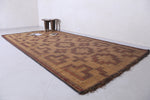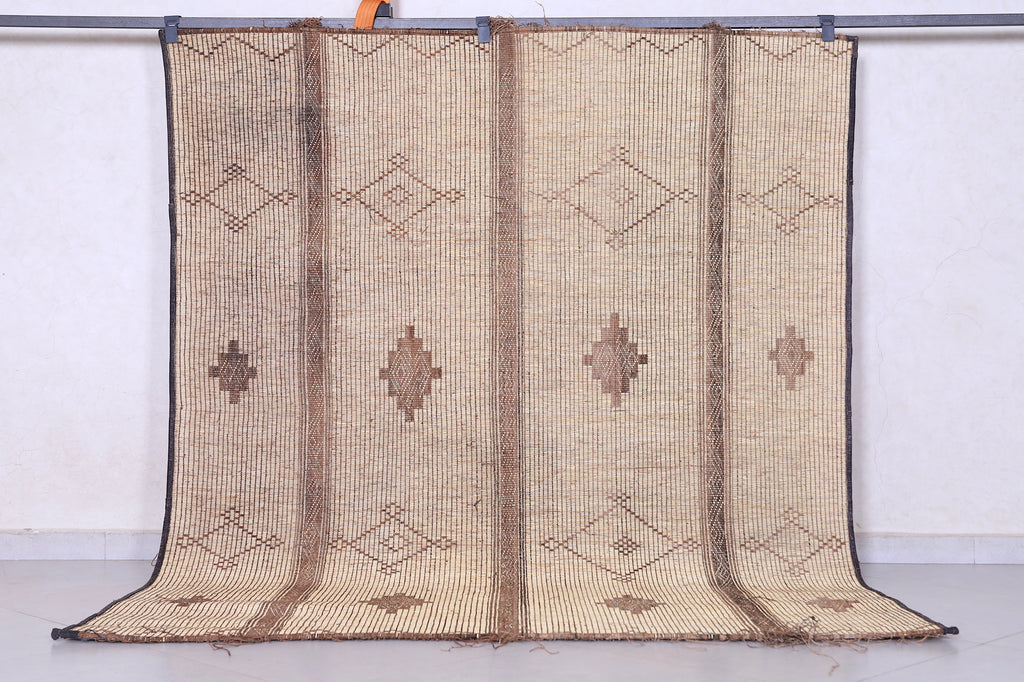No Products in the Cart
Tuareg Mats: Traditional Craftsmanship From The Dessert Sands of Morocco
Have you ever wondered where you can get those gorgeous woven rugs/mats that you always see around people’s homes and gardens? Most of them find their way through the skilled Tuareg craftswomen in Morocco. As an ancient culture, the Tuareg people have been designing unique textiles for centuries to express creativity and make a living. A tende mat is a signature type of mat that comes from the Tuareg, and people love it for the exquisite and vibrant geometric patterns that result from natural wool dyes from the rugs. It is made from sheep’s wool and camel leather and takes a determined craftswoman weeks to create. The mare tells the stories of the people’s cultural heritage, community, and their everyday life. So, let us take a step into the desert sands of Morocco and discover the art of Tuareg mat-making.
The Nomadic Tuareg People and Their Ancient Traditions
The Sahara desert in North Africa has been home to the nomadic Tuareg people for over 1,000 years. The origin of their name, “Blue People”, is thought to be due to the indigo dye that used to color their garments. They are known for their beautiful handcrafted products, among which their woven mats are the most prized. Tuareg women have been hand weaving mats and carpets for hundreds of years using palm fronds, grasses, and camel or goat hair as artificial fibers of natural materials that they can get in the desert. The traditional Northern African mats are used as floor covering, roofing, and seating in the Tuareg traditional tents and houses. It may take them weeks, or even months to make one large mat or carpet. Traditional mats often contain geometric shapes or symbolic animals like camels, gazelles, and areantiti, which is another symbol for camel, as well as Tuareg calligraphy. Northern African mats are attributed to Tuareg based on the location where they were obtained, and the patterns they display as the designs vary among different tribes and regions. To make a mat, artisans harvest palm fronds, reeds, and grass for fibers and spin them into thread. The thread is then woven into a mat by hand on a vertical loom. Tuareg mats remain significant symbols of nomadic culture and a fundamental part of tribal life As the Tuareg become more sedentary, the making of mats has become recognized as a fine art. Tuareg mats are prized by collectors around the world for their intricate weaving and high quality, and you can join them by adding the artistry of Tuareg mats to your home.

How Tuareg Mats Are Made: A Labor of Love
The Tuareg mat is a colorful tapestry epitomizing the Tuareg people’s rich cultural heritage. It is a labor of love that takes women months and months to create. All women must have dried palm leaves which they then roll and twist into long strands. They then have these strands dyed by local plants and minerals to produce colors such as red, orange, and indigo. The dyed long strands are set to dry completely. What follows is nothing short of a tedious, meticulous process. They knot each strand onto the base grid to create the pattern. The knots are stacked one on top of the other, forming a row by row motif. The most common motif types include geometric patterns, images of animals, and Tuareg symbols. This is an extremely slow process that requires time, skill, and dedication. There are usually at least 50 – or even 500 or more – knots per square inch. This means that a single mat may have several hundred thousand knots in total! The final product is thus a vibrant, sturdy work of art that represents the Tuareg peoples’ extensive artistic heritage. Owning can enable you to
Types of Traditional Tuareg Mats: Thick Pile Mats, Thin Reed Mats and Leather Mats
Tuareg mats come in three main types: thick pile mats, thin reed mats, and leather mats. Each serves a distinct purpose in Tuareg daily life.
Thick Pile Mats
Thick pile mats, known as taliouine, are made of woven palm fibers and wool. They provide cushioning and insulation, used for sitting, sleeping and praying. The wool comes from Tuareg sheep and goats, dyed vibrant red, blue and yellow. These mats can last 20-30 years and are often family heirlooms passed down through generations.
Thin Reed Mats
Thin reed mats, or ajouag, are woven from dried reeds found throughout the Sahara desert. They are lightweight, portable and versatile, used as floor coverings, sunshades, and shelter. The reeds are split into thin fibers, dyed, and woven tightly together in geometric patterns. Though less durable than pile mats, reed mats fold compactly for transport and are inexpensive to produce.
Leather Mats
They are mats woven from tanned goat and sheep hides. Leather mats, called tidit, make a soft, waterproof surface for anything from sitting and sleeping to packing goods. Leather mats are tooled, dyed, and express the same bold geometric patterns seen in Tuareg metalwork and jewelry, but they are highly durable. They are harder to make and take more time and effort than pile and reed mats. Art and function emerge from the Sahara sands. The Tuareg mats not only decorate indigenous homes and shelter a nomadic people, but they also continue a long tradition of indigenous craftsmanship in an unforgiving setting. They speak about culture, identity, and living in one of the most difficult places on the planet.
The Symbolism and Meaning Behind the Vibrant Colors and Patterns
The colorful patterns and designs of Tuareg mats hold deep cultural meaning and symbolism for the Tuareg people. The mats feature a vibrant mix of colors with repeating geometric shapes and motifs that represent important elements of Tuareg life.
Colors of the Desert
The main colors used in Tuareg mats are red, blue, yellow and black which are made from natural dyes and pigments found in the local flora and fauna around the desert.
-
Red symbolizes love, warmth and the desert sands.
-
Blue represents the sky and water, two scarce resources in the desert that are revered.
-
Yellow is associated with sunlight, warmth and hospitality.
-
Black signifies maturity and wisdom.
Geometric Shapes
The geometric shapes woven into the mats also have symbolic meaning:
-
Diamonds - Represent prosperity, wealth and fertility. The diamond shape is inspired by the four-chambered stomach of camels which provide the Tuareg with essential resources.
-
Triangles - Signify shelter and the tents the Tuareg call home. The triangle is one of the strongest shapes in architecture and construction.
-
Hexagons - Associated with community, family and the six traditional Tuareg confederations. Hexagons also reflect the efficient, compact shape of honeycombs and geometric tessellation.
-
Circles - Represent continuity, infinity, and the cycle of life. Circles have no beginning or end and signify eternity and timelessness.
The colorful patterns and symbolic shapes woven into Tuareg mats provide a visual representation of Tuareg culture, values and the desert environment. They celebrate themes of community, nature, spirituality and enduring tradition. Each mat tells a story, communicating these ideas through the language of color, form, and symbol.

Tuareg mats in interior design : A Fusion of Tradition and Contemporary Style
Tradition Meets Modern
Tuareg mats offer a fusion of old world craftsmanship and contemporary interior design. Their colorful geometric patterns and durable, natural fiber construction allow them to blend seamlessly into eclectic, bohemian, or minimalist home decor.
-
As accent rugs, Tuareg mats add visual interest and warmth to living rooms, bedrooms, and entryways. Their thick pile provides cushioning underfoot while also defining spaces.
-
For wall art, Tuareg mats make stunning tapestries. Their intricate designs have a painterly quality that livens up blank walls. Secure mats to walls using fabric or rug mounting hardware for easy display.
-
As table runners or placemats, Tuareg mats bring color and texture to dining and side tables. Their naturally stain-resistant wool fibers also make them very practical.
Tuareg mats reflect the nomadic Tuareg people’s artistic sensibilities and connection to the land. Made from dyed and undyed sheep’s wool using traditional weaving techniques passed down through generations, these mats embody Moroccan craftsmanship at its finest. At the same time, their bold geometric patterns feel modern and lend themselves well to contemporary interior design.
A Meaningful Addition to Any Home
Tuareg mats are ideal for every home, which can be used as a rug, wall art, or as a table runner. Door mats offer a unique way to support traditional artisanship, conserve the Tuareg people’s culture and lifestyle, and secure a lovely work of art for the home. The mats have a design that is contemporaneous but timeless. They’re a natural fit for homes, whether they’re decorated in a bohemian or minimalist style and everything in between. Door mats are a fantastic option for the socially conscious consumer. Western consumers are actively helping to preserve the trade by buying Tuareg mats. Fused tradition and current style, rustic and fashionable, are a fantastic approach to inject more life into any home with Tuareg floor mats.
Conclusion
There you have it, an exclusive insight into the elaborate procedure of creating tuareg mats. Next time you find yourself in possession of one of these vibrant rugs, you will know how much care, time, and tradition went into making it. Purchasing one of these handmade rugs will not only afford you the opportunity to R4 the rich legacy of tuareg designs but also help maintain the age-old trade and the talented folk that have spent generations honing their skills. In our rush into a digitally-oriented future, we might lose sight of the wonderful achievements people can craft with their own hands.